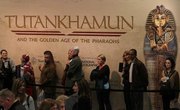Describing a Person’s Nose
Because of its location and prominence on the human face, the nose can be the most recognizable and distinctive feature of an individual. Artists, writers and scientists have long explored the characteristics of this fleshy, triangular appendage. Their efforts have yielded categories of basic shape into which most noses fall, and even links between shape and personality. Aspiring writers can elaborate upon these categories to make their characters' noses as distinct as possible. While some noses can allow for sinuses to influence appearances, plastic surgery or a rhinoplasty are options for those wishing to have different nose shapes.
Understanding Nose Shapes
Though all noses share common underlying structures, outward shapes vary widely with genetics, ethnicity and external factors, such as injuries. The Types of Noses website lists five basic shapes by which most noses can be classified. Flat noses are “under-projected” with wide, flaring nostrils, a short bridge and a rounded tip. Concave noses are upturned, characterized by a concave curve in the bridge that terminates in a protrusive tip. Convex noses curve the other way, “over-projecting” in the center and creating a sloping hump. Wavy noses show an irregular or crooked line along the bridge, and, like convex noses, typically exhibit a bump.
This can be the result of a former injury or a genetic trait. Straight, or Grecian, noses are the opposite. The bridge is completely straight, the nostrils narrow and the tip pointed. Facial features can be explained and described in many ways for different reasons. For example, someone may have a Nubian nose, a Roman nose or a Greek nose based on their cultural background. Others may have more generalized nose features, like a big nose, a celestial nose, a fleshy nose, a hawk nose, a freckled nose, a long nose, an East Asian nose, etc. Other nose features include hooked noses, nasal bones, wide bases, turned-up noses, pointy noses, narrow nostrils, etc.
Describing Nose Shapes
By no means are writers limited to these basic shapes when describing a character's nose. On the contrary, each shape can serve as a framework to help the writer find even more compelling words. For example, maybe you've decided your character has a convex nose. This over-projecting shape lends itself to a variety of adjectives: "He had an imposing, Romanesque nose," or a "hooked, aquiline nose." If your character's nose is small, and flat or concave in projection, you could easily say, "She had the cutest button nose." Similes also can be used to strike effective visuals: "His nose was as thick and crooked as a tree branch," or "a thin and straight as a shark fin."
Understanding Nose Type and Personality
When writing, it helps to understand how physical features like the nose can be indicative of inner character. Writing in “The Daily Mail,” Fiona Macrae describes how 14 types of noses have been linked to specific personality traits. The “fleshy” nose, which is protuberant like the convex nose, was the most common type among men. This nose was associated with sensitivity, generosity, and helpfulness. In contrast, the “snub” nose was described as rare and attractive, a small nose sloping upwards at the tip, yet suggestive of immaturity. These are just some of the connections others have made between physical appearance and personality traits.
Describing Nose Type and Personality
What the nose suggests about inner character is only limited by a writer's imagination. Physical descriptions can be used to reinforce character. The imposing appearance of the convex, Romanesque nose can lend itself to an imposing personality: "He had the hulking, imperious nose of a conquistador." Regarding a thin and straight nose, you might say, "Her long, delicate nose matched her refined sensibilities." Of course, your character's nose may also belie his or her personality. You could draw a contrast between physical appearance and spiritual bearing: "He had a huge, ugly, bumpy nose, but his voice was as soft and kind as summer rain."
Related Articles
References
Writer Bio
Scott Neuffer is an award-winning journalist and writer who lives in Nevada. He holds a bachelor's degree in English and spent five years as an education and business reporter for Sierra Nevada Media Group. His first collection of short stories, "Scars of the New Order," was published in 2014.










